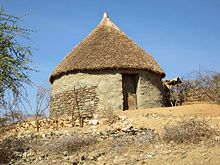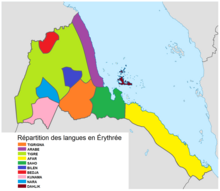| Total population | |
|---|---|
| 121,000[1] | |
| Regions with significant populations | |
| Languages | |
| Bilen | |
| Religion | |
| Predominantly: Islam Minority: Eritrean Orthodox Tewahedo Church and Roman Catholic | |
| Related ethnic groups | |
| Other Agaw peoples, especially Xamirs |


The Bilen (also variously transcribed as Blin, and also formerly known as the Bogo, Bogos[2] or Northern Agaw[3]) are a Cushitic ethnic group in Eritrea. They are primarily concentrated in central Eritrea, in and around the city of Keren and further south toward Asmara, the nation's capital. They are split into two sub-tribes; Bet Tarqe, Bet Tawqe which are split into further clans known as Hissat. The Tawke has six whereas the Tarke has five which each are divided into smaller kinship groups.[4]
Demography
[edit]According to a 2006 estimate, the total population of the Bilen was around 91,000.[5] The Bilens comprise around two percent of the population of Eritrea.[6] The vast majority of the Bilen live in Eritrea but some also live in Ethiopia and Djibouti.[5]
Origins
[edit]Tradition establishes an apparent connection between the Eritrean Bilen and the Ethiopian Agaw which can be seen in linguistic similarities between Agaw and Bilen. The presence of many identical place names in the areas around Lasta and Bogos in central Eritrea further alludes to some historical connection between the two groups. According to local oral tradition, the Bilen lived on the Eritrean plateau from Lasta around the 6th or 7th century when Queen Ben Hammawiya invaded the Lasta province from the North. They then also partially subdued the prior Tigre population.[7][8] A second wave of migration may have occurred according to historians during the fall of the Zagwe dynasty in 1270. The Bilen first appear in historical records from the 14th century onwards.[9] Some of The Bilen/Agaw ruled Eritrea and Ethiopia for 300 years.[10]
Religion
[edit]The Bilen practice both Islam and Christianity. Around two-thirds of the Bilen are Muslim while the rest are Christians.[5] Muslim adherents mainly inhabit rural areas and have intermingled with the adjacent Tigre, while Christian Bilen tend to reside in urban areas and have intermingled with the Tigrinya People (Biher-Tigrinya).[3] Sunni Islam is followed by half of the Bilen, with the other half adhering to Christianity of various denominations.[7][8] The religious diversity of the Bilen has aided the peaceful coexistence among them with little conflict arising due to religious differences.[7]
The Bilen were originally Coptic Christians. In the mid to late 19th century during the Egyptian invasion of the Keren highlands (1860-1876) the Bet Tawqe clan accepted Islam, adopting the faith of their new overlords. The Bet Tarqe clan of the Bilen adopted Catholicism at the hands of French missionaries who offered to protect them from Beni-Amer raids in the area during the second half of the 19th century. There are a few mission-converted Protestants and few Bilen have retained their old Coptic Orthodox beliefs.[4][5]
Economy
[edit]The traditional livelihood of most Bilen consisted of pastoralism. However, the recent migration of other groups into the area resulted in the Bilens taking up other occupations including farming. Most modern Bilen are animal herders and farmers.[8]
Language
[edit]The Bilen speak the Bilen language as a mother tongue, which belongs to the Cushitic branch of the Afro-Asiatic language family. Many also speak other Afro-Asiatic languages such as Tigre and Tigrinya. In addition, younger Bilen often employ Arabic words and expressions in their everyday speech.[3]
Notes
[edit]- ^ Project, Joshua. "Bilen in Eritrea". Retrieved 10 September 2023.
- ^ Pease, A. E. (1909). The Book of the Lion. Ravenio Books.
- ^ a b c James Minahan, Miniature empires: a historical dictionary of the newly independent states, (Greenwood Publishing Group: 1998), pp.77-78.
- ^ a b SF Nadel. (1944)Races and tribes of Eritrea
- ^ a b c d Williams, Victoria R. (2020). Indigenous Peoples: An Encyclopedia of Culture, History, and Threats to Survival, Volumes 1-4. Bloomsbury Publishing. ISBN 979-8-216-10219-9.
- ^ Falola, Toyin; Jean-Jacques, Daniel (2015). Africa: An Encyclopedia of Culture and Society [3 volumes]. Bloomsbury Publishing. ISBN 979-8-216-04273-0.
- ^ a b c Skutsch, Carl, ed. (2005). Encyclopedia of the World's Minorities. New York: Routledge. p. 222. ISBN 1-57958-468-3.
- ^ a b c G., Mussie Tesfagiorgis (2010). Eritrea. ABC-CLIO. pp. 174–175. ISBN 978-1-59884-231-9.
- ^ Connell, Dan (2019). Historical Dictionary of Eritrea. Rowman & Littlefield. p. 119. ISBN 978-1-5381-2066-8.
- ^ Niaz Murtaza, The Pillage of Sustainability in Eritrea, 1600s-1990s: Rural Communities and the Creeping Shadows of Hegemony, (Greenwood Publishing Group: 1998), p.45